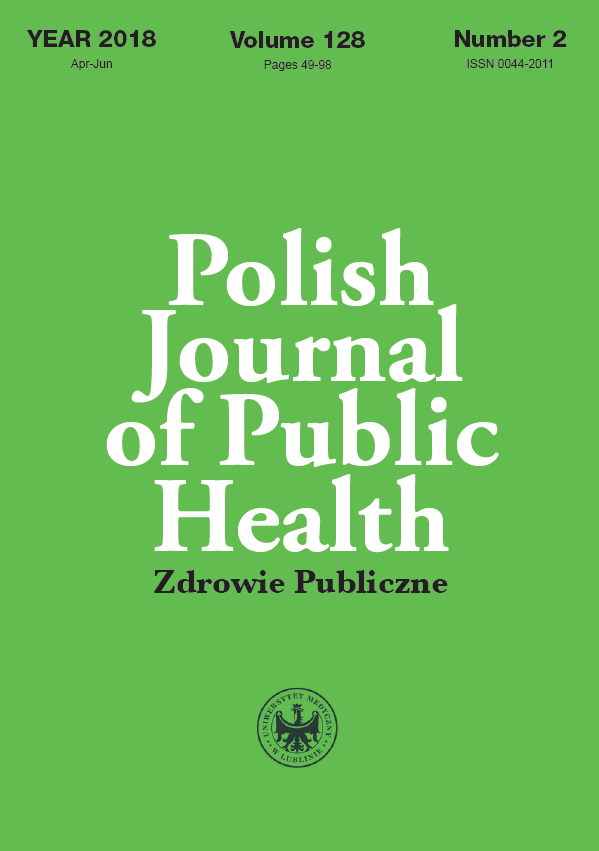Prestige of the medical profession. Is there a connection between feminization and decreased prestige?
DOI:
https://doi.org/10.2478/pjph-2018-0016Keywords:
hierarchy of prestige, feminization of medicine, physicianAbstract
Introduction. Since the dawn of time, one of the characteristics of the medical profession has been its high prestige. It should be underlined, however, that up until the middle of the 19th century doctors were almost exclusively men. For women, who on the wave of emancipation movements, sought to obtain formal opportunities for becoming a physician, studying medicine and obtaining medical practices were rendered impossible and ultimately hindered due to sex discrimination. Since the beginning of the 20th century, the medical profession has begun to succumb to feminization and women’s domination has remained till this day.
Aim. The aim of this article is to present results of research analyzing the position of female doctors in the hierarchy of professional prestige.
Material and methods. Results presented in the article are an outcome of qualitative and quantitative questionnaire studies. Quantitative studies were conducted in 2018 on a representative group of 600 adult Poles. In qualitative research, 29 direct interviews with female doctors were conducted. The research sample was selected using snowball sampling. The respondents were physicians with different seniority who were in the process of specialization or with the title of specialist in the field of eighteen medical specialties.
Results. Among twenty of the evaluated professions, the highest positions in the hierarchy of prestige was obtained by physicians, firefighters and university professors. In direct interviews, female doctors confirmed that their profession enjoys societies’ respect; however, the level of respect for numerous reasons has decreased compared to the past. Some of the respondents attributed this fall to feminization of medicine.
Conclusions. A discrepancy was observed between the physicians’ and society’s opinions. In physicians’ opinion, for various reasons (also due to feminization), the prestige of the medical profession has significantly decreased compared to the past.
References
1. Straus R. Medical sociology: a personal fifty year perspective. J Health Soc Behav. 1999;2:103-10.
2. Szczepański J. Czynniki kształtujące zawód i strukturę zawodową In: A. Sarapata (ed). Socjologia zawodów. Warszawa: Książka i Wiedza; 1965. p. 11-24.
3. Sarapata A. Zawód jako wyznacznik miejsca w społeczeństwie In: A. Sarapata (ed). Socjologia zawodów. Warszawa: Książka i Wiedza; 1965. p. 143-75.
4. Domański H. Prestiż zawodów w obliczu zmian społecznych: 1958-2008. Studia Socjol. 2010;4:79-121.
5. Domański H. Prestiż. Toruń: Wydawnictwo Naukowe Uniwersytetu Mikołaja Kopernika; 2012.
6. Tobiasz-Adamczyk B, Bajka J, Marmon G. Wybrane elementy socjologii zawodów medycznych. Kraków: Collegium Medicum UJ; 1996.
7. Cybulska A. Prestiż zawodów. CBOS. Komunikat z badań. BS/164/2013. https://www.cbos.pl/SPISKOM.POL/2013/K_164_13.PDF (dostęp dnia: 30.03.2018.).
8. Szumowski W. Propedeutyka lekarska. Kraków: Akademia Medyczna im. Mikołaja Kopernika w Krakowie; 1992.
9. Janicka I. Medycynierki, medyczki, lekarki- dyskryminacja naukowa i za¬wodowa kobiet-lekarek w wybranych państwach europejskich oraz USA w XIX wieku. Studia Historica Gedanensia. 2013;4:69-91.
10. Zestawienie liczbowe lekarzy i lekarzy dentystów wg wieku, płci i tytułu zawodowego z uwzględnieniem podziału na lekarzy wykonujących i niewykonujących zawod. Naczelna Izba Lekarska. https://www.nil.org. pl/__data/assets/pdf_file/0017/124505/Zestawienie-nr-03.pdf (dostęp dnia: 30.03.2018.).
11. Babbie E. Podstawy badań społecznych. Warszawa: Wydawnictwo Nau¬kowe PWN; 2008.
12. Charmaz K. Teoria ugruntowana. Praktyczny przewodnik po analizie jakościowej. Warszawa: Wydawnictwo Naukowe PWN; 2009.
13. Hølge-Hazelton B, Malterud K. Gender in medicine – does it matter? Scand J Public Health. 2009;2:139-45.
14. Williams ChL. The glass escalator, revisited: Gender inequality in neolib¬eral times, SWS Feminist Lecturer. Gender & Society. 2013;5:609-629.
15. Ramakrishnan A, Sambuco D, Jagsi R. Participation of women in the medi-cal profession: insights from experiences in Japan, Scandinavia, Russia and Eastern Europe. J Womens Health (Larchmt). 2014;23:927-34.
16. Norredam M. Album D. Prestige and its significance for medical special¬ties and diseases. Scand J Public Health. 2007;6:655-61.
Downloads
Published
Issue
Section
License
Copyright (c) 2018 Polish Journal of Public Health

This work is licensed under a Creative Commons Attribution-NonCommercial-NoDerivatives 3.0 Unported License.


